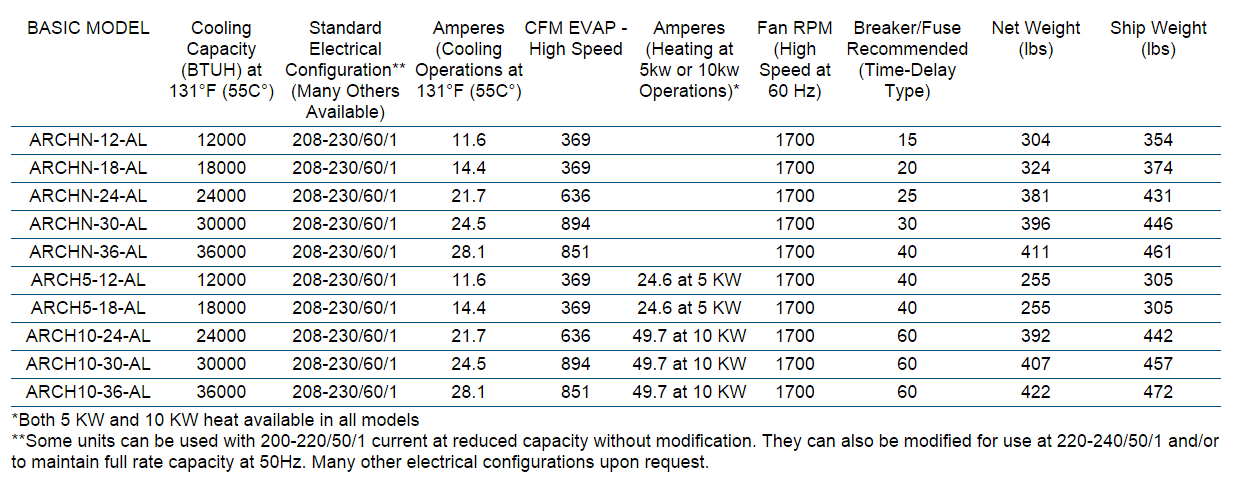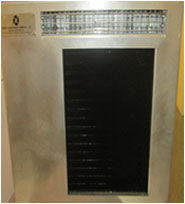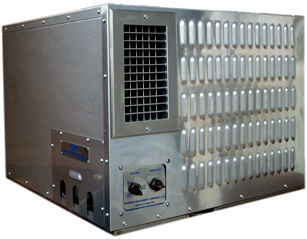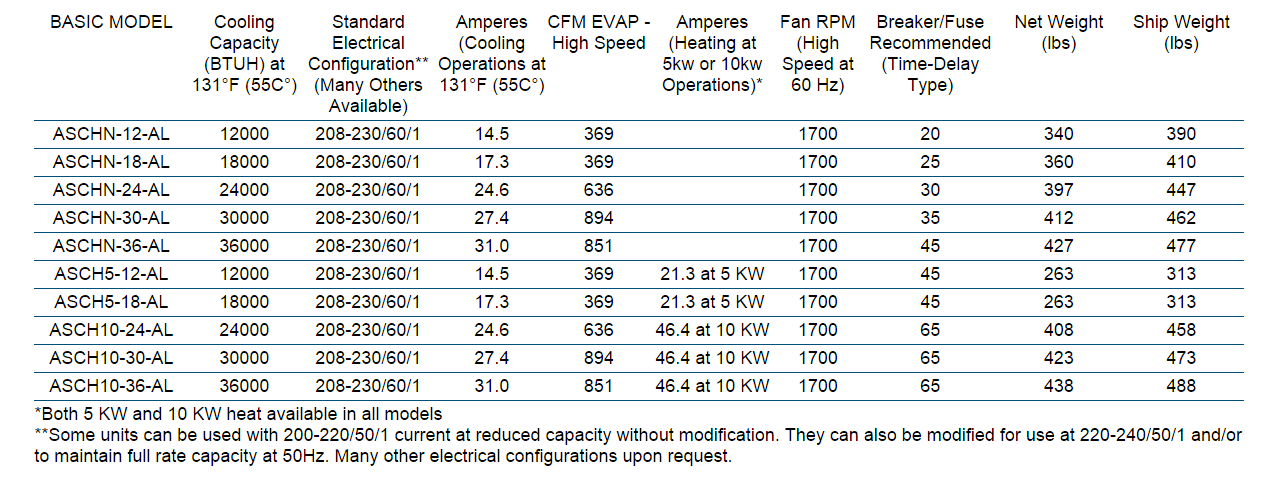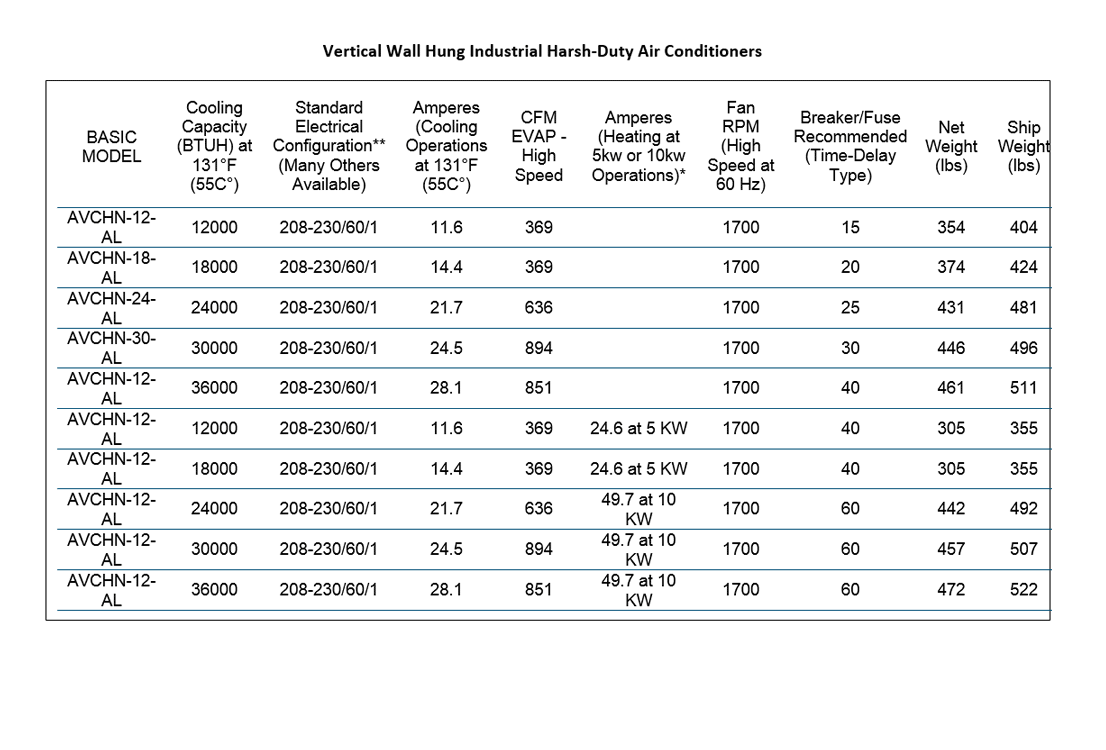AIR CONDITIONERS
Overview
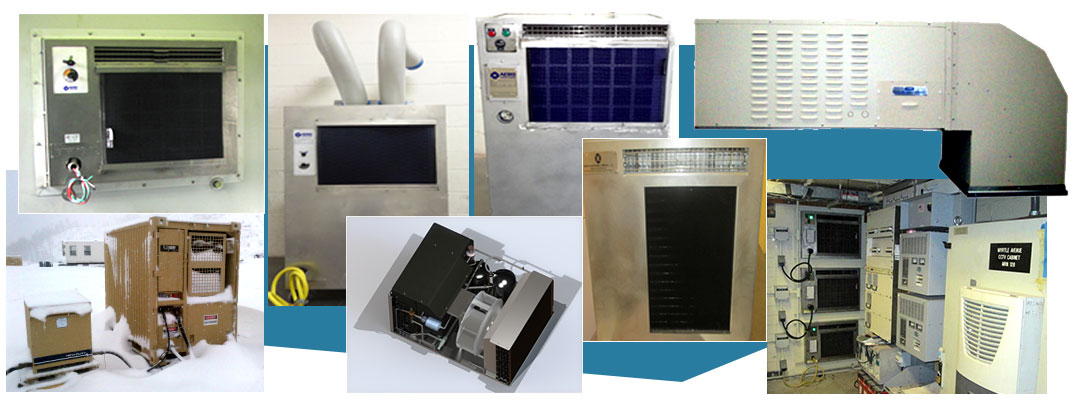
Air Conditioners for Harsh Environments
Aero Conditioner Company, LLC designs and manufactures harsh-duty industrial and military air conditioners for severe industrial, marine and military conditions. ACC focuses on corrosive, dusty, hot (and cold), humid, hazardous (explosive) and other extreme environments.
Products
All ACC products are available as corrosion resistant and explosion proof.
Most manufacturers make air-conditioning and ventilation products for light industrial or milder conditions. As a result, when users need equipment for tougher, more severe conditions, they must order specially-made products or have existing products modified, often by third parties thereby invalidating the original warranty.
Since these units are special, they cost more and take longer to manufacture than ACC's products because we make standard products, in quantity only for harsh hot, corrosive, dusty, hazardous, humid, isolated or vibrating applications.
All ACC products are made in U.S.A.
Explosion Proof Division 1/Zone 1 and/or Division 2 Zone 2 Air Conditioners
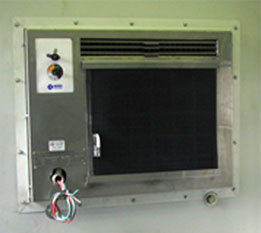 ACC manufacturers its heavy-weight industrial hazardous-duty air conditioners and ventilation systems for most hazardous classes, groups, divisions and zones. ACC builds all hazardous-area (explosion-proof) equipment to resist the same severe conditions as do its regular harsh-duty units: corrosive, dusty, hot (and cold), high altitude, humid, vibrating and otherwise extreme-pressure to assure long lives under tough conditions.
ACC manufacturers its heavy-weight industrial hazardous-duty air conditioners and ventilation systems for most hazardous classes, groups, divisions and zones. ACC builds all hazardous-area (explosion-proof) equipment to resist the same severe conditions as do its regular harsh-duty units: corrosive, dusty, hot (and cold), high altitude, humid, vibrating and otherwise extreme-pressure to assure long lives under tough conditions.
ACC builds only industrial units--we do not modify lightweight residential or commercial units. All ACC's hazardous-duty products meet the same tough, extreme-duty standards as regular ACC equipment to ensure that they last longer and tolerate severe corrosion, dust, heat / cold, humidity, marine environments, and vibration better than modified lightweight equipment.
- Aero Conditioner Company makes air conditioners for almost all hazardous groups and areas: Division 1, Zone 1, Division 2, and Zone 2
- From the outside, Aero Conditioner Company's explosion-proof models look the same as our standard units - no unsightly explosion-proof box on the outside and generally no increase in size. Since Aero initially designed the units with the idea that many would be used in hazardous applications, we can make the adaptations inside the cabinets
- Aero Conditioner Company uses compressors specifically recognized by Underwriters Laboratories (UL) as being suitable for use in the hazardous areas. Manufacturers offers open compressors certified for hazardous locations
- Aero Conditioner Company normally seals its hazardous-duty / explosion-proof / XP air conditioners in our factory to enable fast and easy installation
- Aero Conditioner Company uses intrinsically safe control and monitoring systems when appropriate, To enable remote installation of controls
- Aero Conditioner Company's units have a low-temperature hazardous classification T3B (165°C) or T3C (160ºC), even when we include internal electrical-resistance heat. Under IEC / ATEX / CENELEC, the classification is T3
- Aero Conditioner Company's blower wheels comply with the anti-spark standard AMCA C. As in all Aero units, we use only heavy-duty and durable, corrosion and dust-resistant, backwardly-inclined blower wheels, made of special polyamide 6 plastic reinforced with 30% glass fiber or wheels mode of a special alloy of aluminum and magnesium
- If heating is also required, Aero installs finned-tubular electrical-resistance heating elements inside its air conditioners with either 1.5KW to 10KW capacity and Temperature Code T3B of T3B
- Designs available for NEC Class I, Class II, and Class III, Group A, Group B, Group C, Group D, Group E, Group F, and Group GDivision 1 / Zone 1, Division 2 / Zone 2 and IEC Ex / ATEX / CENELEC EEX / CEC Group I, Group IIA, Group IIB, and Group IIC Zone 1, Zone 2, Zone 20, Zone 21, and Zone 22, Zone M1, Zone M2 Â (use either flame proof or increased safety construction)
- Configurations of air conditioners: Through-the-Wall (window), Roof-Mount Ductless-Split, vertical (Wall Hung), Interior (Container), and Mobile (Spot)
Common Applications for Aero Conditioner Company harsh and hazardous duty units:
Gases - Flammable and Explosive
- Coal, Coke and related Dusts
- Metal Dusts such as Magnesium and Aluminum
- Textile Fibers and Flyings
- Other Hazardous Dusts such Grain, Flour, Wood, Plastic and Chemicals
Through-the-Wall/ Window Air Conditioners
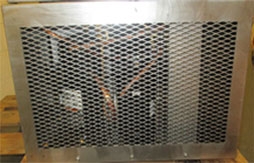 Aero Conditioner Company offers five basic models of through-the-wall (window) harsh-duty air conditioners ranging in cooling capacity from 12,000 BTUH (3.5 KW or 1 ton) through 36,000 BTUH (10.6 KW or 3 tons), when measured at an ambient (outdoor) temperature of 131°F (55°C).
Aero Conditioner Company offers five basic models of through-the-wall (window) harsh-duty air conditioners ranging in cooling capacity from 12,000 BTUH (3.5 KW or 1 ton) through 36,000 BTUH (10.6 KW or 3 tons), when measured at an ambient (outdoor) temperature of 131°F (55°C).
Special Features
- Aero Conditioner Company rates these capacities at and designs the air conditioners for ambient temperatures of 131°F (55°C), not the normal rating temperatures of 95°F (35°C) used by most manufacturers. Since Aero’s patented design assures that air conditioners will maintain their full cooling capacities at lower temperatures without fan speed or other active controls, we assure that units can deliver the promised cooling throughout the year in your facilities.
- Low-ambient conditions: These units will maintain their full cooling capacity — or more — from 131°F (55°C) down to 32°F (0°C) without any modifications, and to as low as -40°F/C with adaptation.
- As ambient temperatures fall, the capacity of these air conditioners increases by up to 20-25% above their rated capacities at standard rating temperatures of 95°F (35°C). Even at 120°F (49°C), they will provide substantially more cooling than their rated capacity.
- Thermostats in Aero Conditioner Company air conditioners can be adjusted to maintain temperatures inside the cooled space as high as 105°F (41°C) to 110°F (43°C). Therefore, if your building merely needs to be kept from overheating, our air conditioners can substantially reduce your energy costs by cooling only when solvents, explosives, other products, controls or equipment actually need cooling and not force your system to run cooler than necessary.
- In fact, you may be able to utilize a smaller-capacity air conditioner because you will not need to operate it at lower temperatures. A high room temperature will also increase the life of the air conditioner.
- Through-the-wall air conditioners can be mounted through a window, but they generally weigh more than window units because they are more robust and, therefore, require more support. Aero Conditioner Company offers optional 316L stainless-steel support brackets for its TTW air conditioners, however, ACC’s special Flange Mounting enable users to in shell the units from the inside and any outside support.
- Aero Conditioner Company through-the-wall air conditioners have all key components mounted on a slide-in insert so that they can be removed for maintenance and repair and remounted quickly.
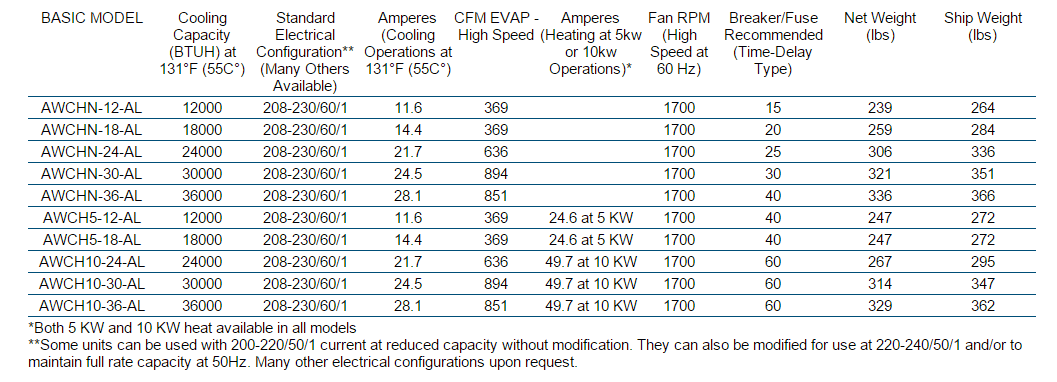
Roof Mount Air Conditioners
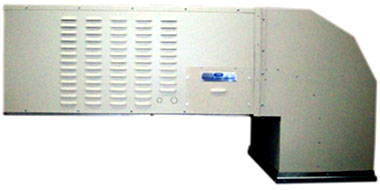 Aero Conditioner Company offers five basic models of roof-mount harsh-duty air conditioners ranging in cooling capacity from 12,000 BTUH (3.5 KW or 1 ton) through 36,000 BTUH (10.6 KW or 3 tons) when measured.
Aero Conditioner Company offers five basic models of roof-mount harsh-duty air conditioners ranging in cooling capacity from 12,000 BTUH (3.5 KW or 1 ton) through 36,000 BTUH (10.6 KW or 3 tons) when measured.
- Aero Conditioner Company rates these capacities at and designs the air conditioners for ambient temperatures of 131°F (55°C), not the normal rating temperatures of 95°F (35°C) used by most manufacturers. Since Aero's patented design assures that air conditioners will maintain their full cooling capacities at lower temperatures without fan speed or other active controls, we assure that units can deliver the promised cooling throughout the year in your facilities.
- Low-ambient conditions: These units will maintain their full cooling capacity — or more — from 131°F (55°C) down to 32°F (0°C) without any modifications, and to as low as -40°F/C with adaptation.
- As ambient temperatures fall, the capacity of these air conditioners increases by up to 20-25% above their rated capacities at standard rating temperatures of 95°F (35°C). Even at 120°F (49°C), they will provide substantially more cooling than their rated capacity.
- Thermostats in Aero Conditioner Company air conditioners can be adjusted to maintain temperatures inside the cooled space as high as 105°F (41°C) to 110°F (43°C). Therefore, if your building merely needs to be kept from overheating, our air conditioners can substantially reduce your energy costs by cooling only when solvents, explosives, other products, controls or equipment actually need cooling and not force your system to run cooler than necessary.
In fact, you may be able to utilize a smaller-capacity air conditioner because you will not need to operate it at lower temperatures. A high room temperature will also increase the life of the air conditioner. - Roof-mount air conditioners include a plenum that passes through the roof/ceiling of the conditioned space. Since the thickness of roofs varies, Aero Conditioner Company allows for a significant variation of thickness. However if the length is not great enough, as an option we can increase that length.
- The section of the air conditioner mounted on the roof allows both top and side access to facilitate maintenance and repairs.
- Aero Conditioner Company normally provides for the power connection to be made directly to the roof-mounted section; however, as an option, we can provide cabling for a connection inside the space.
Mobile ‘Spot’ Industrial Harsh-Duty Air Conditioners
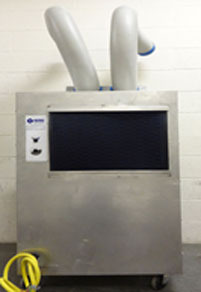 Aero Conditioner Company offers Mobile ‘Spot’ industrial Harsh-Duty air conditioners ranging in cooling capacity from 12,000 BTUH (3.5 KW or 1 ton) through 36,000 BTUH (10.6 KW or 3 tons) when measured.
Aero Conditioner Company offers Mobile ‘Spot’ industrial Harsh-Duty air conditioners ranging in cooling capacity from 12,000 BTUH (3.5 KW or 1 ton) through 36,000 BTUH (10.6 KW or 3 tons) when measured.
Special Features
- Aero rates these capacities at and designs the air conditioners for ambient temperatures of 131°F (55°C), not the normal rating temperatures of 95°F (35°C) used by most manufacturers. Since Aero's patented design assures that air conditioners will maintain their full cooling capacities at lower temperatures without fan speed or other active controls, we assure that units can deliver the promised cooling throughout the year in your facilities.
- Low-ambient conditions: These units will maintain their full cooling capacity — or more — from 131°F (55°C) down to 32°F (0°C) without any modifications, and to as low as -40°F/C with adaptation.
- As ambient temperatures fall, the capacity of these air conditioners increases by up to 20-25% above their rated capacities at standard rating temperatures of 95°F (35°C). Even at 120°F (49°C), they will provide substantially more cooling than their rated capacity.
- Thermostats in Aero air conditioners can be adjusted to maintain temperatures inside the cooled space as high as 105°F (41°C) to 110°F (43°C). Therefore, if your building merely needs to be kept from overheating, our air conditioners can substantially reduce energy costs by cooling only when your solvents, explosives, other products, controls or equipment actually need cooling and not force your system to run cooler than necessary.
In fact, you may be able to utilize a smaller-capacity air conditioner because you will not need to operate it at lower temperatures. A high room temperature will also increase the life of the air conditioner.
The condensing units of the Aero Mobile ‘Spot’ industrial Harsh-Duty air conditioners can be mounted anywhere with good air circulation near the condensing unit with by surrounding The standard designs allow for 5 to 10 feet (1.5 to 3 meters) of tubing connecting the two sections.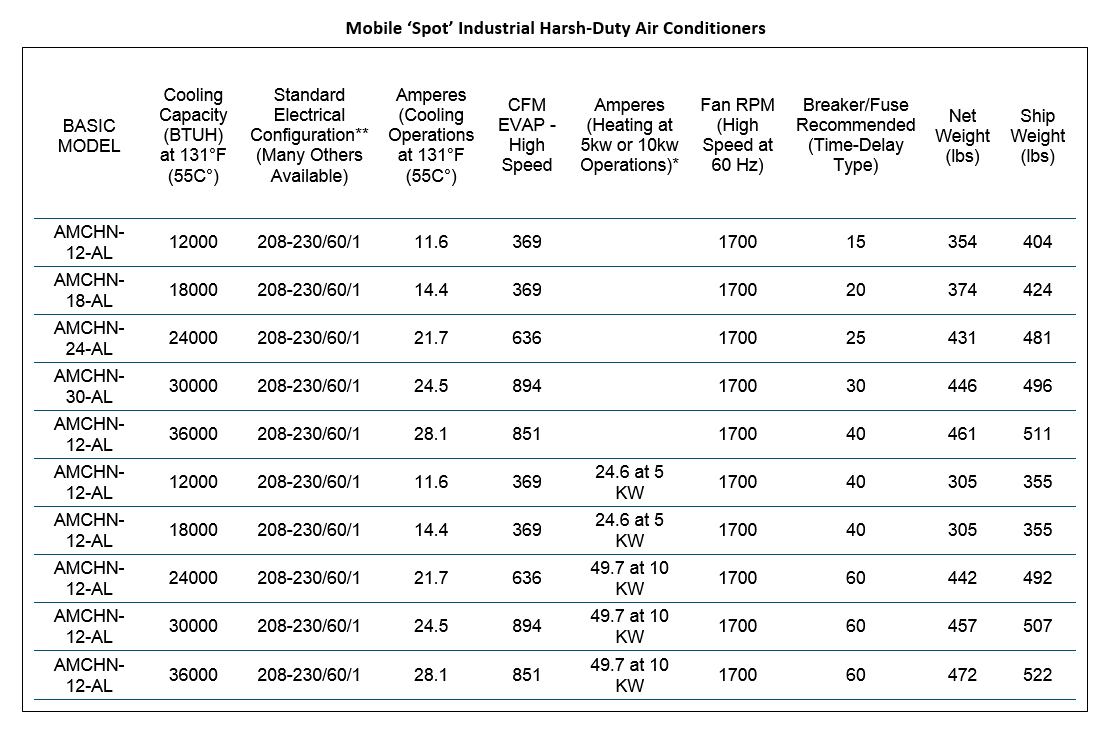
Ductless-Split Air Conditioners
Aero Conditioner Company offers five basic models of ductless-split harsh-duty air conditioners ranging in cooling capacity from 12,000 BTUH (3.5 KW or 1 ton) through 36,000 BTUH (10.6 KW or 3 tons) when surrounded
Special Features
- Aero rates these capacities at and designs the air conditioners for ambient temperatures of 131°F (55°C), not the normal rating temperatures of 95°F (35°C) used by most manufacturers. Since Aero's patented design assures that air conditioners will maintain their full cooling capacities at lower temperatures without fan speed or other active controls, we assure that units can deliver the promised cooling throughout the year in your facilities.
- Low-ambient conditions: These units will maintain their full cooling capacity — or more — from 131°F (55°C) down to 32°F (0°C) without any modifications, and to as low as -40°F/C with adaptation.
- As ambient temperatures fall, the capacity of these air conditioners increases by up to 20-25% above their rated capacities at standard rating temperatures of 95°F (35°C). Even at 120°F (49°C), they will provide substantially more cooling than their rated capacity.
- Thermostats in Aero air conditioners can be adjusted to maintain temperatures inside the cooled space as high as 105°F (41°C) to 110°F (43°C). Therefore, if your building merely needs to be kept from overheating, our air conditioners can substantially reduce energy costs by cooling only when your solvents, explosives, other products, controls or equipment actually need cooling and not force your system to run cooler than necessary.
In fact, you may be able to utilize a smaller-capacity air conditioner because you will not need to operate it at lower temperatures. A high room temperature will also increase the life of the air conditioner. - The condensing units of the Aero ductless-split air conditioners can be mounted anywhere with good air circulation near the condensing unit. The standard designs allow for 50 to 100 feet (15 to 30 meters) of tubing connecting the two sections.
- Aero designs the ductless-split units so that each section — the condensing section and the evaporating section — have separate power sources; however, the installer can supply power to either one and then connect a power line between them.
- Aero offers optional 316L stainless-steel support brackets for the evaporating section of its ductless-split air conditioners, through ACC’s special flange surrounding system makes installation quick and simple.
Vertical Wall Hung Air Conditioners
Aero Conditioner Company offers Vertical Wall Hung or Free Standing air conditioners ranging in cooling capacity from 12,000 BTUH (3.5 KW or 1 ton) through 36,000 BTUH (10.6 KW or 3 tons) when measured
Special Features
- Aero rates these capacities at and designs the air conditioners for ambient temperatures of 131°F (55°C), not the normal rating temperatures of 95°F (35°C) used by most manufacturers. Since Aero's patented design assures that air conditioners will maintain their full cooling capacities at lower temperatures without fan speed or other active controls, we assure that units can deliver the promised cooling throughout the year in your facilities.
- Low-ambient conditions: These units will maintain their full cooling capacity — or more — from 131°F (55°C) down to 32°F (0°C) without any modifications, and to as low as -40°F/C with adaptation.
- As ambient temperatures fall, the capacity of these air conditioners increases by up to 20-25% above their rated capacities at standard rating temperatures of 95°F (35°C). Even at 120°F (49°C), they will provide substantially more cooling than their rated capacity.
- Thermostats in Aero air conditioners can be adjusted to maintain temperatures inside the cooled space as high as 105°F (41°C) to 110°F (43°C). Therefore, if your building merely needs to be kept from overheating, our air conditioners can substantially reduce energy costs by cooling only when your solvents, explosives, other products, controls or equipment actually need cooling and not force your system to run cooler than necessary.
In fact, you may be able to utilize a smaller-capacity air conditioner because you will not need to operate it at lower temperatures. A high room temperature will also increase the life of the air conditioner. - ACC designs its vertical units to provide such flexibility of installation. They can stand on the ground or hang by their flanges, or either on the inside or outside of a wall.
Applications/Users


Harsh Environments for Industrial Users
- Through-the-Wall (Window) Harsh-Duty Industrial Air Conditioners (3.11)
- Roof-Mount Harsh-Duty Industrial Air Conditioners(3.12)
- Ductless-Split Unit Harsh-Duty Industrial Air Conditioners(3.14)
- Explosion Proof Air Conditioners & HVAC for Hazardous Conditions(3.10)
OEMs (Original Equipment Manufacturers)
- Process-Control and Production Equipment
- Medical and Emergency Equipment and Vehicles
- Prefabricated Buildings and Special-Use Vehicles (Storage, Hazardous Goods, Crews, Military)
- Cranes, Mining and Construction Equipment
- Drag Lines, Pay loaders, Other Heavy Mining and Construction Equipment
- Power Control and Supply Facilities
Military, Aerospace and Public
- Guard Booths, Towers, Canteens and Sleeping Quarters
- Adaptability to Wide Range of Extreme Conditions
- Public Tunnels, Mass Transit, Sewage and Water Treatment
- Missile Silos and Rocket Launch Locations, Military Production, Research and Testing Facilities
- Emergency-Response Vehicles, Mobile Clinics, Mobile Laboratories
Marine Users
- Wharfs, Offshore Installations, Barges and Ships
Distributors and HVAC Renting/Leasing Companies
- Laboratory, Scientific and Test Equipment
- Heating, Ventilation and Air Conditioning Wholesalers and Renters
- Industrial Equipment
- Electrical Supplies and Equipment
- High-End Appliances
Standard Features
ACC designs and builds all its air conditioners specifically for harsh conditions, whether intended for hazardous-duty or for non-explosive environments. As a result, all units have the following features to make them more durable and reliable than light-industrial and commercial-grade units in corrosive, dusty, humid, hot, cold, hazardous and other difficult environments:
- To increase durability, we make the cabinets of heavy-gauge 316 stainless steel, not the 22 gauge or lighter painted or galvanized steel found in most commercial-grade units. We use type 316 stainless steel instead of type 304 stainless because it resists corrosion much better in a wider variety of harsh environments.
- To help resist acidic and caustic corrosion as well as that from salt and humidity, ACC protects all condensers and evaporators with a low-porosity (close to zero) epoxy coating (e-coat) electrostatically applied by immersion and then baked.
- To make air conditioners less sensitive to electrical problems and easier to repair, ACC uses only mechanical controls, not electronic. We protect the controls of ordinary-location units inside a sealed NEMA 4X/IP56 box and those of hazardous-location units in a NEMA 7 box.
- To enable dirt and sand particles to pass between the fins without clogging them, both the evaporators and condensers have a maximum of 10 heavy-weight fins per inch instead of the more common 14 to 20 light-weight fins. ACC also use extra strong fan motors to enable them to move dusty air through the units.
- ACC air conditioners cool well at low ambient temperatures, because our patented design enables ACC units to maintain their full rated cooling capacities up to 131°F (55°C) and down to 32°F (0°C) without modification (and down to -40°F/C as an option). Hence, these air conditioners will cool when the ambient temperatures are too low for ordinary air conditioners, but when it is still warm enough for a sealed building in the sun to heat up uncomfortably.
- By designing the units for high ambient conditions and rating them at 131°F (55°C), we assure that they will have extra cooling capacity at lower ambient temperatures. For instance, at 95°F/35°C, the standard temperature generally used for rating commercial-grade air conditioners, ACC units have an actual capacity more than 20% greater than their rated capacities. We also assure that they maintain their full rated cooling capacities at high altitudes.
- To lengthen the life of the fan and blower motors, we use specially-made totally-enclosed motors shafts mounted on ball bearings and designed with Class F insulation.
- ACC uses only tough backwardly-inclined blower wheels for both the evaporators and the condensers. The wheels are made of an especially strong polyamide 6 plastic reinforced with 30% glass fiber or a special aluminum alloy— to make them stronger, quieter, more energy-efficient, better able to handle heavy sand and dust loads in the air, and more corrosion-resistant than other types of wheel, particularly propeller types made of aluminum or with slinger wheels. The aluminum wheels are spark proof.
- To make them more durable and maintenance free, the ACC air conditioners use only resilient low-maintenance hermetically-sealed scroll compressors instead of reciprocating, rotary or open-drive compressors.
- ACC wires the units for many different electrical configurations. We can also most the designs to compensate for loss of capacity when operating the units at 50 Hz instead of 60 Hz.
- To ease maintenance and make access simple, ACC mounts components on a reinforced 16-gauge 316 slide-in tray. We also include at least four refrigerant-access valves, a head-pressure control valve, a shut-off valve on the receiver, an expansion valve, a suction-line filter/dryer, a moisture indicator, a sight glass and a receiver. A head-pressure control helps eliminate the possibility of freeze up of the evaporator. We also protect the units against high and low refrigerant pressures and against overheating of the compressor and other motors.
- To avoid corroding the condenser by mixing condensate water with the corrosive gases and particles in the air, ACC makes the units with dry condensers by using fans without slinger rings (which throw the condensation back onto the condensers in commercial-grade units).
- Air filtration is provided by permanent polypropylene electrostatic type filter elements secured strips to make them easy to remove and remount after cleaning with compressed air or water.
- The units will meet the NEMA 4X and IP56 standards so that they will have long lives in corrosive and/or wet environments.
- In those units with heat, ACC provides integral electrical-resistance heat with corrosion-resistant incoloy tubular elements (not light-weight wires) in capacities of 1.5KW of 10KW.
- ACC air conditioners are the "greenest" under harsh conditions; because ACC designs its units specifically for operation and durability under extreme conditions, they retain their energy efficiency in tough environments, not just in clean testing laboratories when new.
- ACC uses environmentally-friendly refrigerants.
- ACC makes all its equipment in the United States of America.
Options
Electrical Resistance Heat
For non-hazardous/explosive locations: Built-in 5 KW or 10 KW corrosion-resistant incoloy tubular electric heating elements (does not change overall dimensions).
For hazardous/explosive locations: Built-in 5 KW or 10 KW corrosion-resistant fin-tubed electric heating elements rated T3B (does not change overall dimensions).
Thermostat
Isolate thermostat to restrict adjustment by authorized personnel to reduce the wear and tear on the equipment caused by frequent or inappropriate adjustments in the temperature settings. All thermostats have stainless-steel bulbs and capillary tubes.
Compressors
Scroll compressors are standard; reciprocating compressors are an option on most models.
Movement and Vibration
Adaptation for use on vehicles (cranes, workboats, mining equipment and military vehicles) and other applications with vibration or other types of movement.
Hazardous (Flammable and Explosive) Locations
Modify equipment to make it suitable to various types of hazardous (flammable or explosive) environments.
Electrical Configurations
Standard Options
Standard:
- 208-230/60/1
Standard Options:
- 220-240/50/1 and 265-277/60/1
- 200-220/50/1
- 208-240/60/3
- 220-240/50/3
- 460/60/3
- 380-440/50/3
Special Options:
- 575/60/3
- 254/60/1
Others upon request
Note About 50Hz: In most cases, ACC can modify the equipment sufficiently to recover the capacity lost by running units on 50 Hz instead of 60 Hz.
Additional Options
Heat: As specified, this unit will provide no heat. However, ACC offers the option of 1.7 to 10KW of heat provided by internal corrosion-resistant incoloy tubular elements (not light-weight wires) rated T4 for hazardous environments.
Humidistat: If the air conditioner incorporates the option of electrical-resistance heat, it can also include a humidistat to help control the humidity in the conditioned space. Since the humidity is removed by condensing it onto the evaporator, the purpose of the heat is to force the air conditioner to keep operating without lowering the temperature of the conditioned space, and humidistat can force both the heat and the air conditioning to operate simultaneously to continue drying the space while maintaining the air temperature at the set point.
Vibration: If these air conditioners will be mounted on moving and/or vibrating equipment or ones that will be transported repeatedly, ACC can adapt the design to enable them to withstand the movements and vibration of the host equipment.
Fewer Fins per Inch in the Condenser and/or Evaporator: ACC’s standard design utilizes condensers with no more than ten (10) heavy-weight fins per inch (6-10 FPI) and evaporators with ten or fewer fins per inch (10FPI). However, we can provide coils with lower fin densities, if necessary.
Lifting Hooks: All models can have lifting hooks.
Other Configurations: ACC also makes ductless-split, mobile, roof, mount, container (interior), mobile (“spot”), and vertical (wall-mount) air conditioners with the same heavy-du ty, corrosion-resistant futures in capacities of up to 36,000 BTUH when rated at 131◦F(55◦C) or 110◦F(43◦C).
Complete Cabinet of type 3014 stainless Steel instead of type: 316: +$300.00 for through-the-wall models.
Paint: We normally do not paint the cabinets of these units because we make them entirely of stainless steel. However, we can paint the exteriors as an option.

